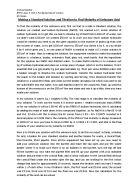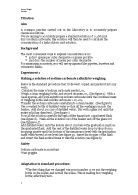Titration. As the purpose of the titration is to determine the concentration of potassium hydroxide solution, in order to analyse this unknown solution, we must have a standard solution (hydrochloric acid) to react with the unknown solution.
ACCESS CHEMISTRY
UNIT A
Practical Assignment – Titration
Introduction
Titration is a laboratory method of determining the concentration of a known reactant and is also known as volumetric analysis. Two solutions are involved. One solution is measured and poured into a flask, whilst the other is poured into a burette and added drop by drop until the required reaction is completed.
The purpose of titrations is usually to determine the concentration of an unknown solution whilst knowing the chemical equation for the reaction by using a known concentration of a second solution. Titrations can also be used to determine the equation for a reaction whilst the concentrations of both solutions are known.
A PH indicator is usually used to determine the endpoint of the reaction, although not all reactions require an indicator as the colour change occurs in the reaction between the two solutions.
As the purpose of the titration is to determine the concentration of potassium hydroxide solution, in order to analyse this unknown solution, we must have a standard solution (hydrochloric acid) to react with the unknown solution. The standard solution is one in which the concentration is known.







